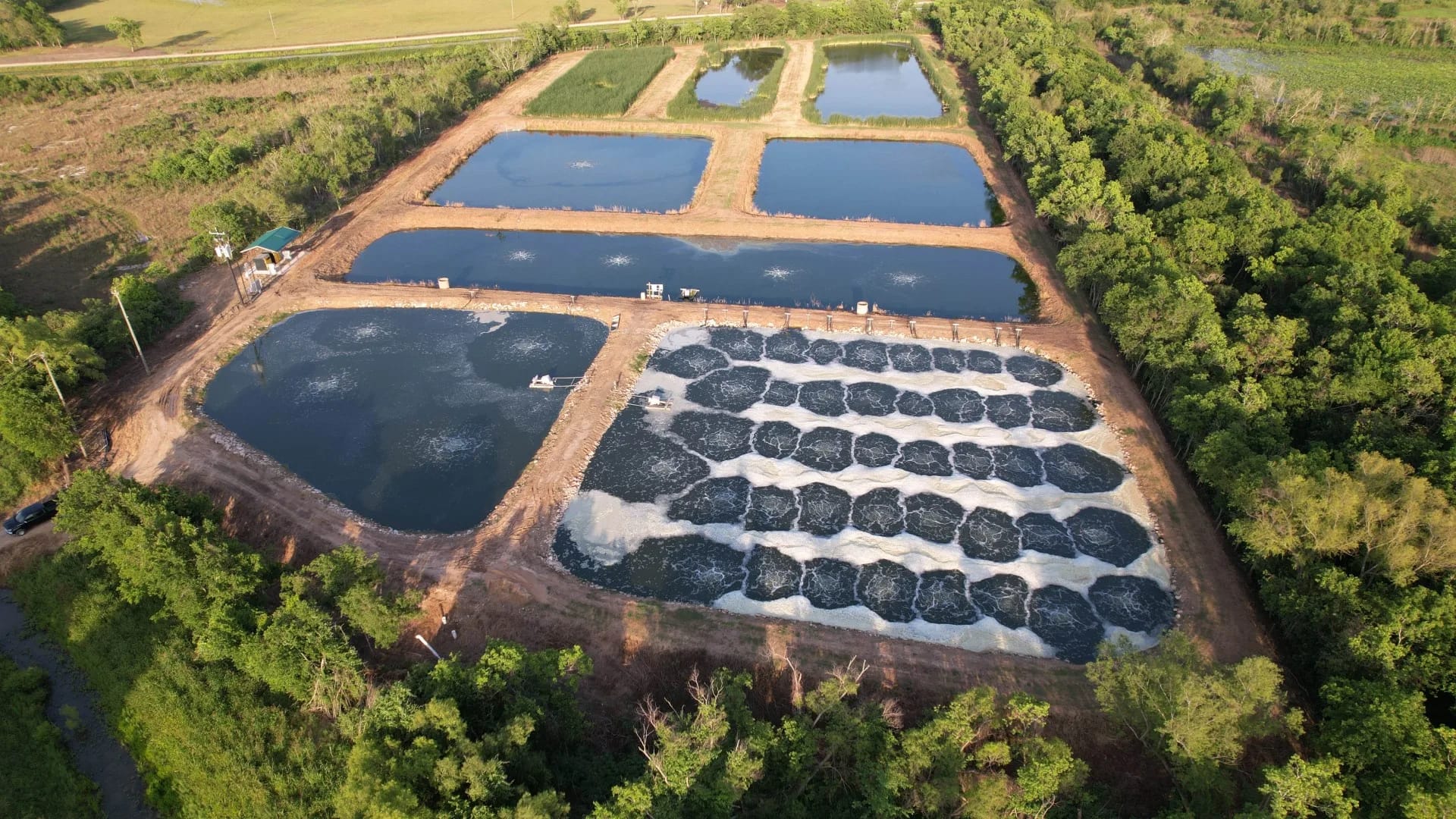Frustrated by His Lagoons’ Poor Performance and Odor Issues, Trung Nhan of Best Sea-Pack Turned to YouTube and Found an Expert: Triplepoint
In 1999, Trung Nhan and his wife Cindy were looking for a location in the Houston area to start a wild-caught shrimp processing business. After much searching, Nhan found an abandoned catfish processing plant in Danbury, a small town in Brazoria County, Texas. While the property was nothing to look at, it had exactly what the couple needed for their new venture: a large building and wastewater treatment lagoons.
“We didn’t have a lot of capital,” Nhan says. “But looking at the property, I saw an opportunity. We mortgaged our house and borrowed from friends and family to buy it and start Best Sea-Pack of Texas.”
Retrofitting the building to process shrimp was fairly straightforward. The treatment lagoons were another matter. The original owner had set up the first two of the system’s four lagoons up as anaerobic; no oxygen was used to process the wastewater. Best Sea-Pack began processing shrimp and immediately experienced a big problem. The lagoons couldn’t handle the load.
Says Nhan, “There was too much odor. We started to get complaints.”
The solution at the time was to convert all of his seafood processing wastewater lagoons to aerobic and add surface aerators to the first three ponds. For the first few years of the business, Best Sea-Pack was not processing high volumes of shrimp, so the surface aerators seemed to be working. But as production volumes grew, the odor problem returned. Making matters worse, the surface aerators required constant maintenance and used a tremendous amount of energy.
Nhan was frustrated for a number of reasons. Best Sea-Pack is a seasonal business. The company purchases fresh-caught shrimp from Texas and Louisiana fishermen who must adhere to state-mandated shrimping seasons that typically run from mid-July to the end of December. During the busy season, the company employs about 50 people. From January through April, the workforce cuts back to about 20 people.
“We are a small company. We have just one person who is responsible for keeping all of our equipment and mechanical systems running. We don’t have the manpower to do the weekly maintenance the surface aerators needed,” he explains.

Also irritating for Nhan was the inability of the surface aerators to properly process the water. “Before the water enters the lagoons, all of the shrimp heads and shells are screened out. We don’t use any chemicals to process shrimp, so everything we put in the lagoons is organic. Eventually it would break down on its own, but oxygen speeds the process. And we weren’t getting enough oxygen to do the job.”
Finally, the bad odor from the seafood processing wastewater lagoons was more than a nuisance. The Texas Commission of Environmental Quality had notified Best Sea-Pack that it was exceeding its ammonia limits. Their processed water was not meeting state requirements for discharge. They would be fined if they didn’t get their numbers in check.
Nhan knew changes had to be made to Best Sea-Pack’s wastewater processing. His goal was to find a solution that would allow him to modify his existing lagoons rather than change the system entirely.
“I began researching and learned more about wastewater treatment than I imagined. I also started calling local people in Texas and got proposals. The recommendations were for totally new systems, expensive systems, and would require experts to maintain them,” he says.
“I didn’t want to do that. I couldn’t do that.”
Triplepoint's YouTube Channel Has the Answers
Then Nhan did what any other sane person would do and jumped on the Internet to do his own research. There he found Triplepoint Environmental and its YouTube Channel with more than 20 case studies explaining their approach to aeration, ammonia removal, and other solutions for food processing plants as well municipal wastewater treatment plants. You’d have thought Nhan had found the best Netflix series ever—he binged every single one.
“I kept watching their channel and could see these guys were the experts. They specialize in lagoons and their technology seemed to be the best.”
What intrigued Nhan was Triplepoint’s approach to lagoon aeration. The company’s patented Ares Aerators® sit on the bottom rather than on the surface of lagoons and use a combination of fine and coarse bubbles to disperse and mix oxygen into the water, which accelerates treatment. The Ares Aerators are controlled on the shore via a blower that connects to each aerator with flexible, heavy-duty tubing and blower PLC for automated control remote monitoring and system alerts.
Says Nhan, “I saw this and said, ‘This is the way to go!’”
In early 2021, a lead came into Triplepoint’s headquarters in Centennial, Colorado, and was given to Justin Bell, a technical sales representative, who reached out to Best Sea-Pack.
Says Bell, “Trung invited us to come to Texas to evaluate his system to determine what we thought needed to be done. Once I got to Best Sea-Pack and evaluated from start to finish, it was obvious aeration was a major cause of the ammonia issue. There were other issues with the levees like erosion, sediment buildup, and overall inefficiency that also needed to be addressed.”
Before he would invest in a Triplepoint solution, Nhan asked to see Triplepoint’s aerators in action. Thus Bell and Nhan traveled to Tennessee to visit several locations with the Ares Aerators and talk to operators. “To see the Ares working gave me an understanding and confidence in the system. After this trip, I was ready to get started.”
Nhan’s first stipulation was that Triplepoint use as much as the existing infrastructure as possible. This included three main cells—the first a high-density treatment cell and the next two for settling—leading to wetlands with cattails to bring nitrogen levels down further before discharging into a local creek.
The second stipulation was the system had to be capable of processing 170,000 gallons a day during the busy season and as the company grows, make it simple to expand to 260,000 gallons a day. Triplepoint agreed to the terms and received a signed purchase order in April 2021 for a two-phase, turnkey job. Included in Phase One was project design, engineering, and build; remediation of the individual cells where needed; installation of all new equipment; and startup services.
Despite delays caused by COVID-related supply chain issues, Triplepoint completed the Best Sea-Pack wastewater treatment project in time for the 2023 shrimp season, which began in mid-May with small volumes of shrimp. By the time the season really started rolling in mid-July and into October, Nhan’s confidence in the new Ares Aeration system was high.
“There is no problem with odor, even standing next to the lagoons,” he grins. “Our processed water levels of ammonia, TSS, and BOD are way below our permitted amount. We’re also seeing a 10 to 15 percent decrease in our energy costs despite the Ares Aerators being a higher horsepower than our old surface aerators.”
What is making Nhan happiest, however, is the fact that he doesn’t have to do anything with the Ares Aerators or employ experts to run the system. It’s a set-it-and-forget-it kind of system. “All of the controls are on the shore, so we don’t touch the aerators at all. Just turn a switch on or off and adjust the time. That’s it.”
Best Sea-Pack will continue processing shrimp until the end of December, when activity shifts to delivering shrimp to wholesalers for busy retail seasons. At this point, Nhan will circle back to Bell and Triplepoint to discuss Phase Two expansion plans. He says Phase Two will be a breeze.
“I had Triplepoint include extra infrastructure during Phase One so all we need to do to add processing capacity is install more Ares Aerators. What could be easier?” he smiles.
Download the Ares brochure


